PicoScope 6000E series of multichannel USB oscilloscopes up to 3 GHz
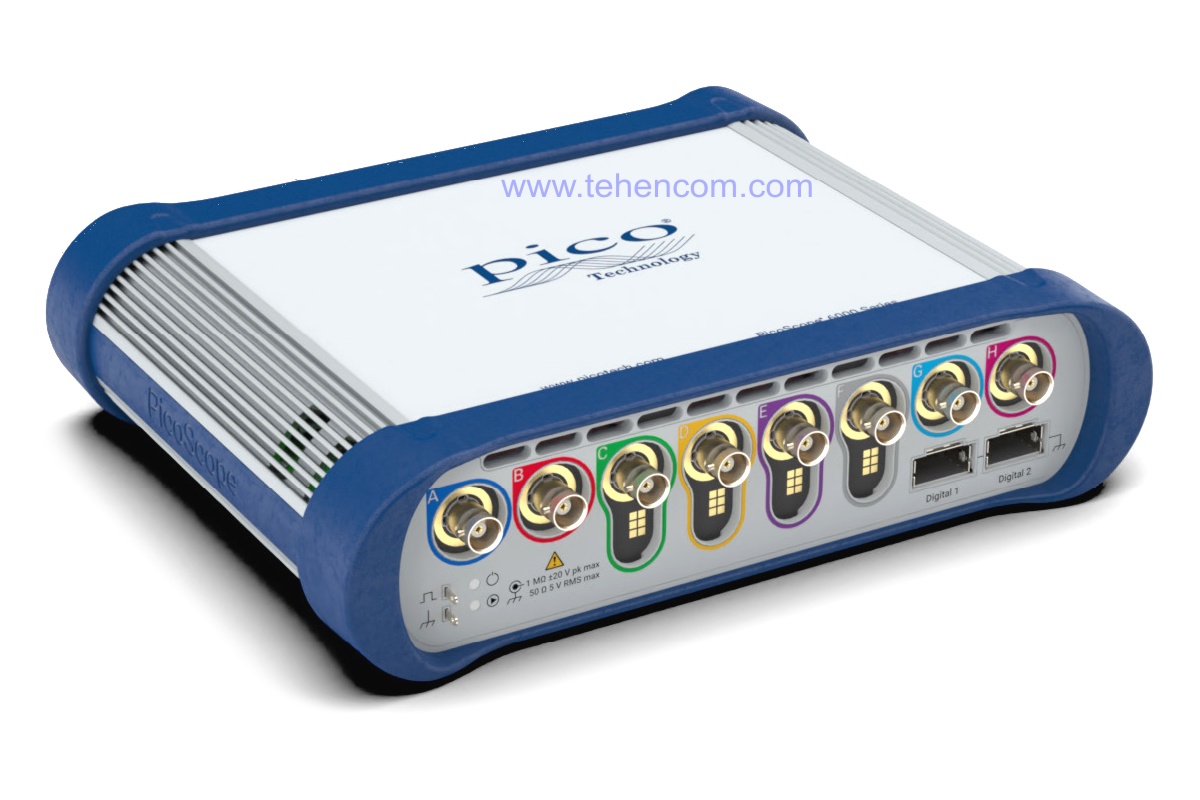
Brief description of the series
Digital Oscilloscope Series PicoScope 6000E companies Pico Technology (United Kingdom) contain up to 8 analog channels with a bandwidth of up to 3 GHz and a sampling rate of up to 10 GS/s, as well as 16 digital channels. Large built-in memory (up to 4,096 million results) and high acquisition speed (up to 300,000 waveforms per second) enable efficient development and debugging of multi-channel embedded systems. It is especially worth noting that the ability to decode and analyze twenty-two serial protocols (I2C, I2S, SPI, CAN, LIN, UART, FlexRay, Ethernet, USB, etc.) is included in the basic package of each device.
Oscilloscopes of the PicoScope 6000E series are connected to a computer via the USB 3 interface and are controlled using the powerful Russified PicoScope 6 software, which is included in the package. We recommend that you pay attention to a special fixture for convenient fixing of the PCB under test, eight analog probes and two digital probes (order code PQ219 kit). You can download a full description of all the characteristics of these oscilloscopes below on this page in the section Documentation.
All models of the series
The Pico Technology PicoScope 6000E series consists of ten models, which are presented in this interactive table. To see all the characteristics of certain models, add them to the comparison.
| Model |
Bandwidth
|
Analog channels
|
Digital channels
|
Sample rate
|
Vertical resolution
|
Record length
|
|---|---|---|---|---|---|---|
|
6403E
|
300 MHz | 4 | 8 16 | 2.5 GS/s | 8 bits | 1 000 M points |
|
6404E
|
500 MHz | 4 | 8 16 | 5 GS/s | 8 bits | 2 000 M points |
|
Promotion
6424E
|
500 MHz | 4 | 8 16 | 5 GS/s | 8 bits 10 bits 12 bits | 4 000 M points |
|
6804E
|
500 MHz | 8 | 8 16 | 5 GS/s | 8 bits | 2 000 M points |
|
Expert's choice
6824E
|
500 MHz | 8 | 8 16 | 5 GS/s | 8 bits 10 bits 12 bits | 4 000 M points |
|
6405E
|
750 MHz 500 MHz | 4 | 8 16 | 5 GS/s | 8 bits | 2 000 M points |
|
6425E
|
750 MHz 500 MHz | 4 | 8 16 | 5 GS/s | 8 bits 10 bits 12 bits | 4 000 M points |
|
6406E
|
1 GHz 500 MHz | 4 | 8 16 | 5 GS/s | 8 bits | 2 000 M points |
|
6426E
|
1 GHz 500 MHz | 4 | 8 16 | 5 GS/s | 8 bits 10 bits 12 bits | 4 000 M points |
|
Novelty
6428E-D
|
3 GHz | 4 | 8 16 | 10 GS/s | 8 bits 10 bits 12 bits | 4 000 M points |
Main features of the series
300 MHz, up to 2.5 GS/s, 4 channels + 16 digital channels, 8-bit ADC (model PicoScope 6403E).
500 MHz, up to 5 GS/s, 4 channels + 16 digital channels, 8-bit ADC (model PicoScope 6404E).
500 MHz, up to 5 GS/s, 4 channels + 16 digital channels, 8-12 bit ADC (model PicoScope 6424E).
500 MHz, up to 5 GS/s, 8 channels + 16 digital channels, 8-bit ADC (model PicoScope 6804E).
500 MHz, up to 5 GS/s, 8 channels + 16 digital channels, 8-12 bit ADC (model PicoScope 6824E).
750 MHz (50 Ohm), 500 MHz (1 MOhm), up to 5 GS/s, 4 channels + 16 digital channels, 8-bit ADC (model PicoScope 6405E).
750 MHz (50 Ohm), 500 MHz (1 MOhm), up to 5 GS/s, 4 channels + 16 digital channels, 8-12 bit ADC (model PicoScope 6425E).
1 GHz (50 Ohm), 500 MHz (1 MOhm), up to 5 GS/s, 4 channels + 16 digital channels, 8-bit ADC (model PicoScope 6406E).
1 GHz (50 Ohm), 500 MHz (1 MOhm), up to 5 GS/s, 4 channels + 16 digital channels, 8-12 bit ADC (model PicoScope 6426E).
3 GHz (50 Ohm), up to 10 GS/s, 4 channels + 16 digital channels, 8-12 bit ADC (model PicoScope 6428E-D).
If multiple channels are active, the sample rate is reduced (see table).
Recording length (total, depends on the model): from 1,024 M to 4,096 M points.
Vertical resolution: 8 bits or 8-12 bits. Sensitivity: 2 mV/div to 4 V/div.
Continuous waveform capture rate (DPO mode): up to 300,000 waveforms/s.
All models in the series include a standard and arbitrary waveform generator (14 bit AWG).
Decoding and analysis of twenty-two protocols: I2C, I2S, SPI, CAN, LIN, UART, Ethernet, USB, etc.
15 automatic measurements, FFT analysis, mathematical signal processing.
Powerful PicoScope 6 software included in the scope of delivery.
Interfaces: USB 3 (it is possible to connect to USB 2 with a special cable).
Weight: 2.2 kg. Dimensions: 245 × 62 × 192 mm. Working temperature: from 0°С to +40°С.
Most modern oscilloscopes contain two or four analog channels, but when developing and debugging modern electronics, this is often not enough and an engineer may need six or more analog channels to work effectively. The PicoScope 6000E series oscilloscopes are specially designed for this task. They contain up to eight analog channels and 16 digital channels. These oscilloscopes make complex, time-synchronized, multichannel measurements easy.
Such an impressive set of features is harmoniously complemented by a new retention system for the prototype board under study and all probes connected to it (shown in the photo below). It securely fixes boards of various sizes, which relieves the developer of the need to simultaneously hold several probes with his hands and significantly increases the convenience of work.
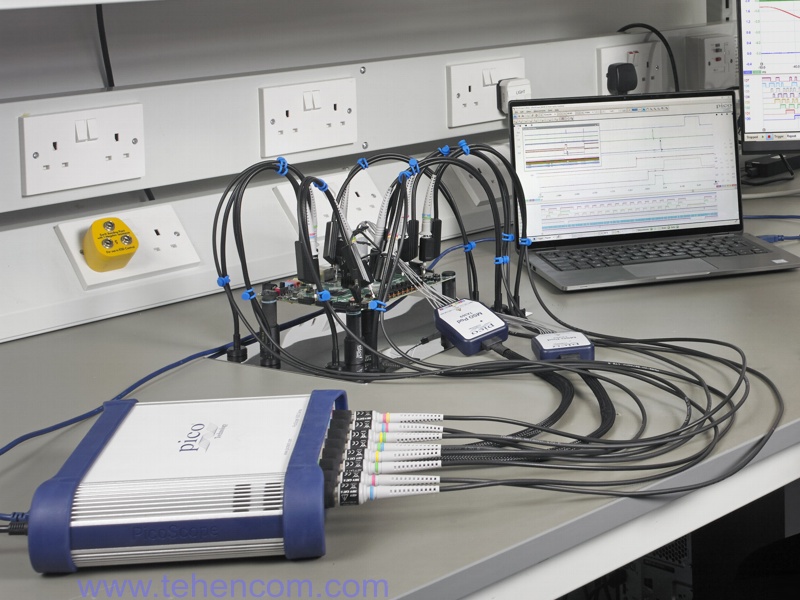
In addition to a large number of channels, the PicoScope 6000E oscilloscopes offer huge built-in memory (1, 2, or 4 Gsample), hardware support for digital phosphor (DPO) technology with an update rate of up to 300,000 wfms per second, and standard decoding and analysis of a large number of popular serial protocols: I2C, I2S, SPI, CAN, LIN, FlexRay, 1-Wire, UART (RS-232 / RS-422 / RS-485), Ethernet, USB, etc.
Need an inexpensive USB oscilloscope up to 200 MHz? Watch the series PicoScope 3000D.
Need 8-channel oscilloscope with screen? Watch the series Tektronix MSO5.
Difficult to decide on a model? See helper: How to quickly choose an oscilloscope.
All series of modern oscilloscopes are presented here: Digital oscilloscopes.
PicoScope 6000E series video review
The PicoScope 6000E series oscilloscopes contain up to eight analog channels and up to sixteen digital channels, provide up to 3 GHz bandwidth, very large on-chip memory up to 4,000,000,000 samples (4 GigaSamples), 8–12 bit hardware resolution ADC, and many other features. This dynamic announcement introduces the PicoScope 6000E series and its key features, such as the new system for holding the prototype board and all probes attached to it.
Professional Features
Pico Technology's oscilloscopes compare favorably with their competitors in that all possible functionality is immediately included in the scope of delivery of the device and it does not need to be purchased for additional money. Among the professional features that are available in any model of the PicoScope 6000E series, they deserve special attention: hardware resolution up to 12 bits, huge built-in memory (2 or 4 billion samples - GSamples) with segmentation capability and hardware timestamps, DPO digital phosphor technology (300,000 waveforms/s), decoding and analysis of serial protocols, logic analyzer for 16 digital channels, built-in generator standard and arbitrary waveforms (14-bit AWG), mask testing, and more.
In addition to the impressive functionality you get at the start, you will be able to receive new features for free throughout the entire period of using your PicoScope 6000E, which are periodically added by Pico Technology both to the PicoScope 6 control software and to the firmware of the oscilloscope itself.
As a demonstration of one of the many interesting features of the PicoScope 6000E series, this screenshot shows an oscillogram of a signal and a table with the results of automatic measurements of the parameters of this signal (rise time, pulse width, etc.). It is impressive that for this series of oscilloscopes, the table with the results of automatic measurements can contain up to a million lines. This is a very useful tool considering that the onboard memory holds up to 4 billion samples.

Hardware resolution up to 12 bits
The PicoScope 6000E Series oscilloscopes provide accurate measurement of your signals with low-noise, carefully shielded front ends that significantly reduce noise, crosstalk between channels, and harmonic distortion.
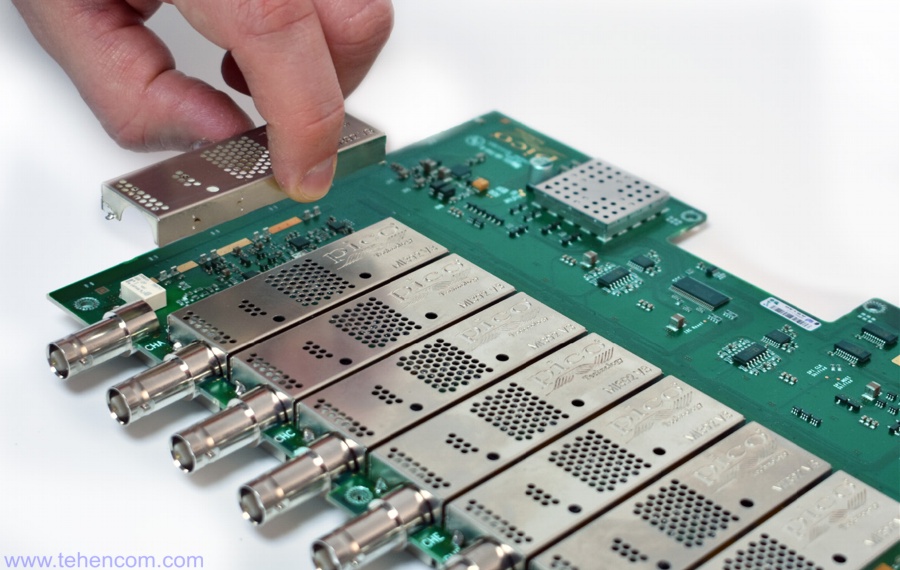
An even greater improvement in measurement accuracy is possible when using two top models PicoScope 6824E (8 channels) or PicoScope 6424E (4 channels), which allow you to change the resolution of the built-in ADCs in the range from 8 to 12 bits (this technology is called FlexRes - flexible resolution). Please note that FlexRes technology is not a classic software averaging, but a hardware implementation. As a demonstration, this screenshot shows the same sine signal digitized at different vertical resolutions: 8 bit, 10 bit, and 12 bit. Obviously, when using the 12-bit mode, the shape of the signal under study is visible much better.
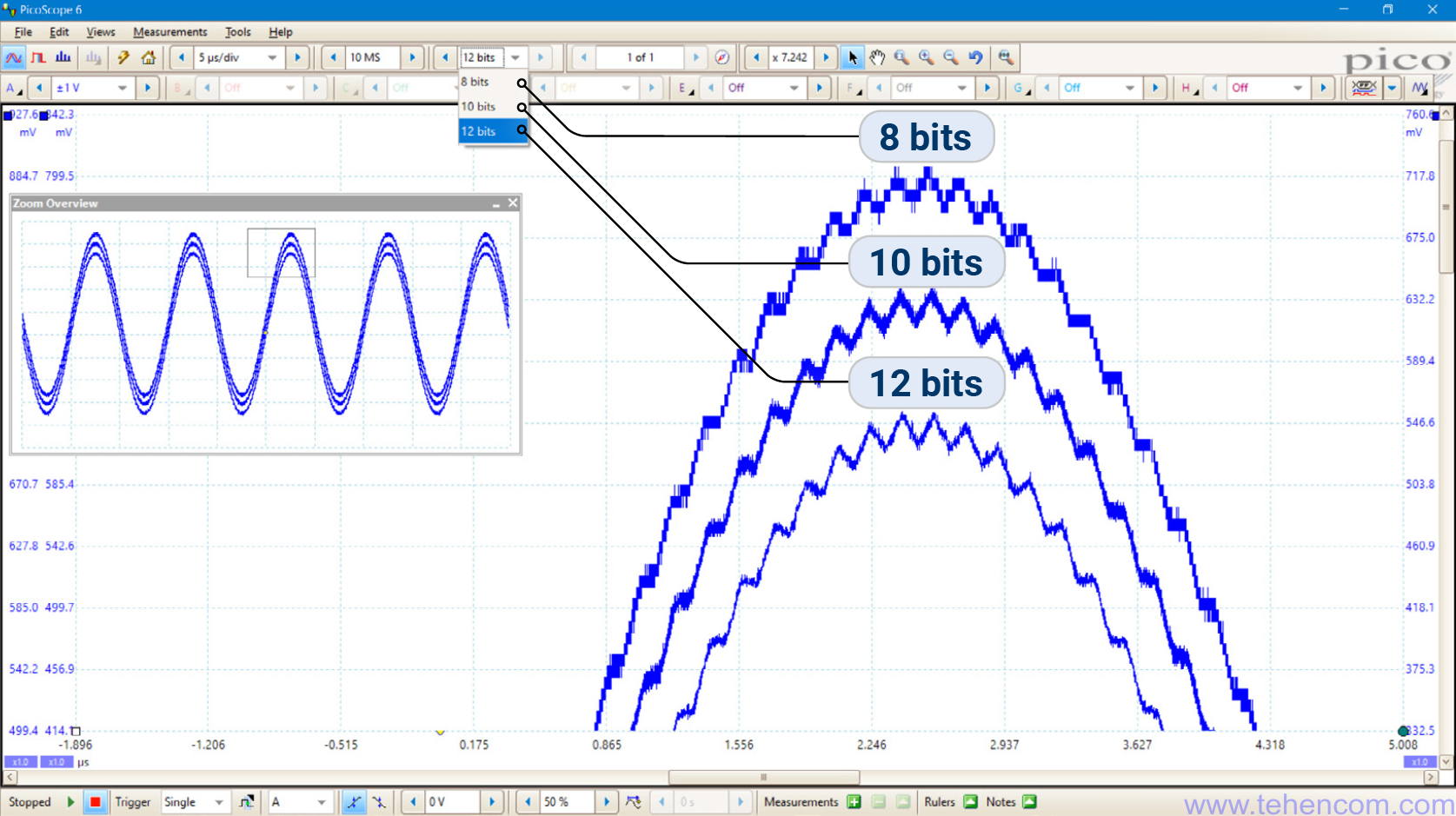
With PicoScope 6000E 8-channel oscilloscopes with one or two analog channels active, each channel is sampled at 5 GS/s. If more than two channels are active, such as three analog channels or two analog channels and 8 digital channels, then the sample rate is reduced.
This figure shows the actual sampling rate for each channel of the eight-channel model in 8-bit ADC mode, depending on the number of active channels and their combinations. The sampling rate of four-channel models, in 10 and 12 bit modes, as well as when digital channels are activated, is given below on this page in the section Documentation.

Large built-in memory
An impressive amount of built-in memory (Ultra-deep memory) is another advantage of the PicoScope 6000E series oscilloscopes. The lower model of the 6403E series contains 1,024 million bytes of internal memory (1 GS), and the older model 6824E contains 4,096 million bytes of internal memory (4 GS at 8-bit resolution, or 2 GS at 10 or 12-bit resolution). This allows you to capture signals of significant duration at full speed.
Those who have used oscilloscopes with large built-in memory know the importance of a fast hardware accelerator capable of real-time processing of millions and billions of samples stored in memory. The PicoScope 6000E series oscilloscopes include this hardware accelerator (brand name HAL4), so waveform handling is smooth and lag-free. Every time you interact with the PicoScope 6 control software, the hardware processor instantly retrieves the data needed for visualization from the oscilloscope's internal memory and sends it to the computer screen.
PicoScope 6000E oscilloscopes have two more professional features that complement the large amount of internal memory: memory segmentation and hardware time stamping. In segmentation mode, the entire amount of internal memory is divided into separate parts (maximum 10,000 segments). At each trigger event, the signal is digitized and stored in its segment with the exact time stamp stored, and the minimum time between two separate triggers can be as little as 300 ns. By storing up to 10,000 signal acquisitions in this way, you can search among them, for example, to find various anomalies.
This screenshot shows a 2,500,000 sample signal sampled by the PicoScope 6824E with 10 bits of vertical resolution. The entire signal is presented in the upper left part of the screen (in a small window), and its enlarged fragment containing one pulse with an abnormally low amplitude is shown in the lower part of the screen.
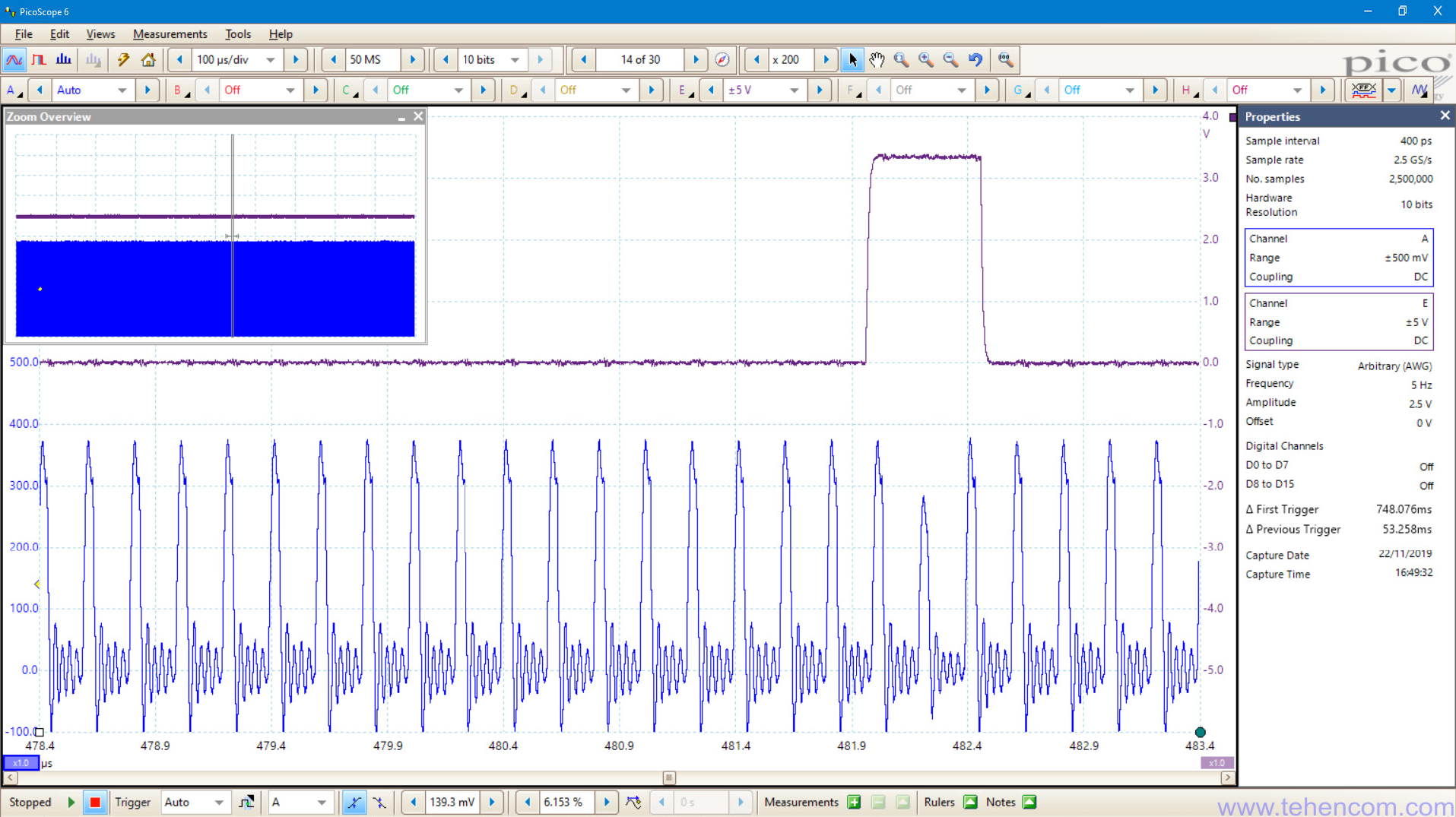
Rare event detection
In this mode, the PicoScope 6000E series digitizes and displays up to 300,000 waveforms per second, superimposing them one on top of the other and highlighting with brighter colors those areas of the screen where the signal appears most often. Such a high speed of processing and visualization of oscillograms became possible thanks to the HAL4 hardware accelerator built into the oscilloscope.
The digital phosphor mode is great for finding rare anomalies (glitches, runts, timing failures), for detecting floating amplitude or frequency of a signal, measuring jitter, and also for checking whether a signal matches a given mask. You can read more about this mode in a special article: DPO digital phosphor technology.
This screenshot shows the operation of the digital phosphor function, which is called Persistence mode in Pico Technology's documentation. Red and yellow colors show places where a signal is more often detected, and shades of blue show places where a signal is rarely detected.

Decoding of serial protocols
Decoding and analysis of serial bus signals is an integral part of the development and debugging of many electronic devices. PicoScope 6000E Series Oscilloscopes as standard can work with the following serial protocols: 1-Wire, ARINC 429, BroadR-Reach, CAN and CAN-FD, DALI, DCC, DMX512, Ethernet 10Base-T and 100Base-TX, FlexRay, I2C, I2S, LIN, PS/2 , Manchester, Modbus, SENT, SPI, UART (RS-232 / RS-422 / RS-485) and USB 1.1. Please note that for various series of oscilloscopes, this functionality must be purchased, and for the PicoScope 6000E series, it is absolutely free.
An example of FlexRay serial protocol decoding is shown in this screenshot. Two serial bus signals are displayed at the top and bottom of the screen, and a very detailed table of decoded values, including timestamps, headers, data, and so on, is in the middle.
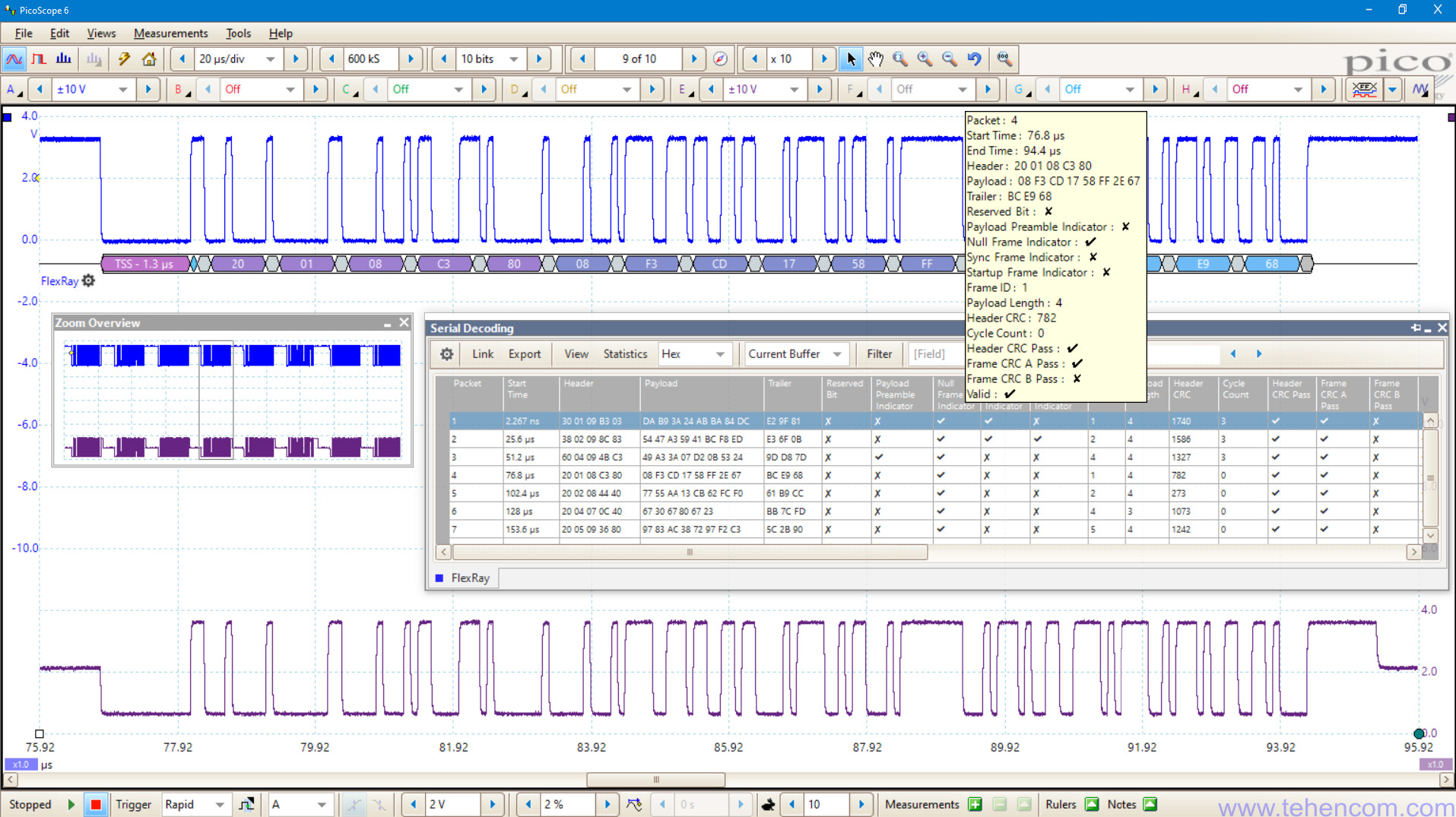
Here is another example of decoding and parsing the popular I2C serial protocol. Oscillograms of the two signals of this serial bus are located at the top of the screen (blue and red graphs), and at the bottom right is a table of decoded values of this protocol.
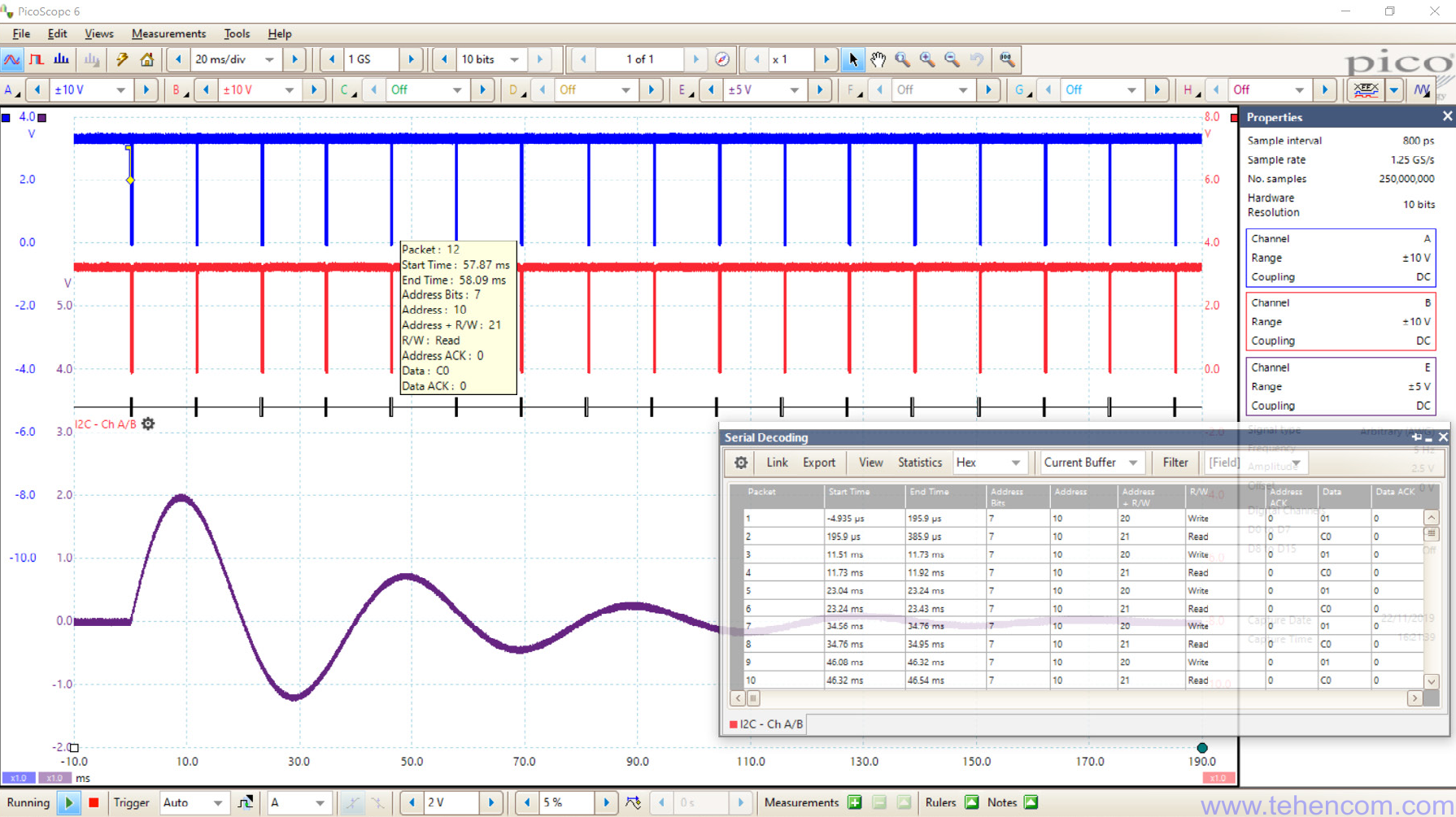
Logic analyzer for 16 digital channels
In addition to four or eight analog channels, the PicoScope 6000E series oscilloscopes provide 16 digital channels (two ports with 8 channels each). To use these additional channels as a logic analyzer, one or two TA369 digital probes must be connected to the oscilloscope. If you need 8 digital channels, then you need one TA369 probe, and if you need 16 digital channels, then use two TA369 probes. The ports for connecting logic probes are shown in this photo (located on the lower right side of the front panel, labeled Digital 1 and Digital 2).

This photo shows the appearance of the TA369 digital probe when connected to the test prototype. Each such probe adds eight digital channels to the PicoScope 6000E oscilloscope. The probe consists of an extension cable, a small module containing matching electronics, and eight wires with interchangeable tips of different types for connecting to digital signals.
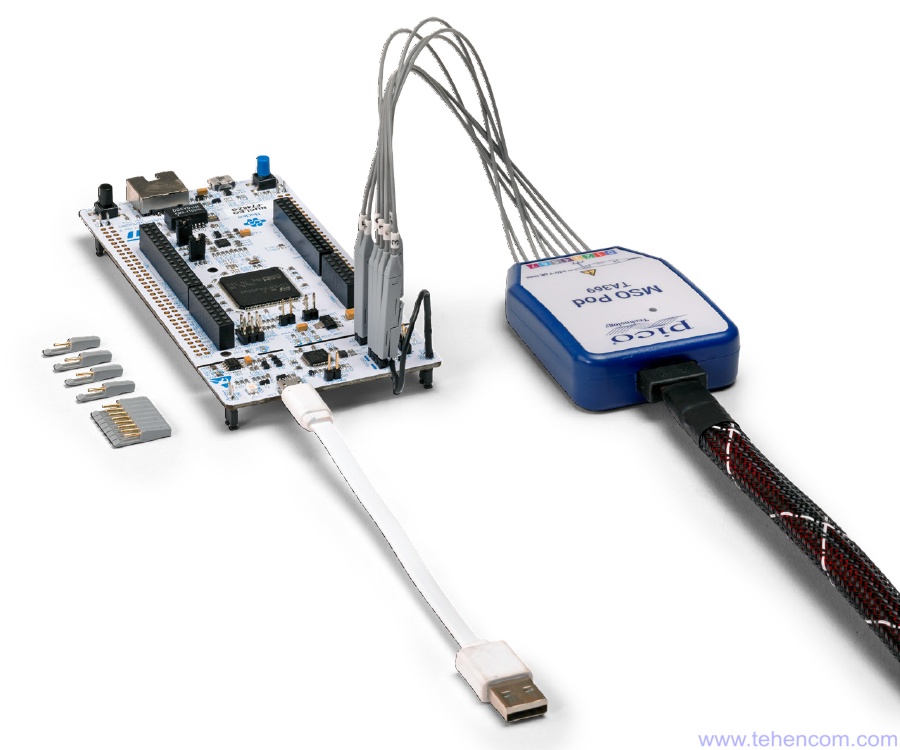
Immediately when one or two TA369 digital probes are connected to the PicoScope 6000E oscilloscope, the logic analyzer functionality for the corresponding number of channels (8 or 16) is activated in the PicoScope 6 control program. Each digital channel is digitized at 1 GS/s, and the digital probe has its own input capacitance of 3.5 pF, which has virtually no effect on the signal under study (rise and fall times). An example of the operation of a logic analyzer when examining a 12-bit digital bus is shown in this screenshot.
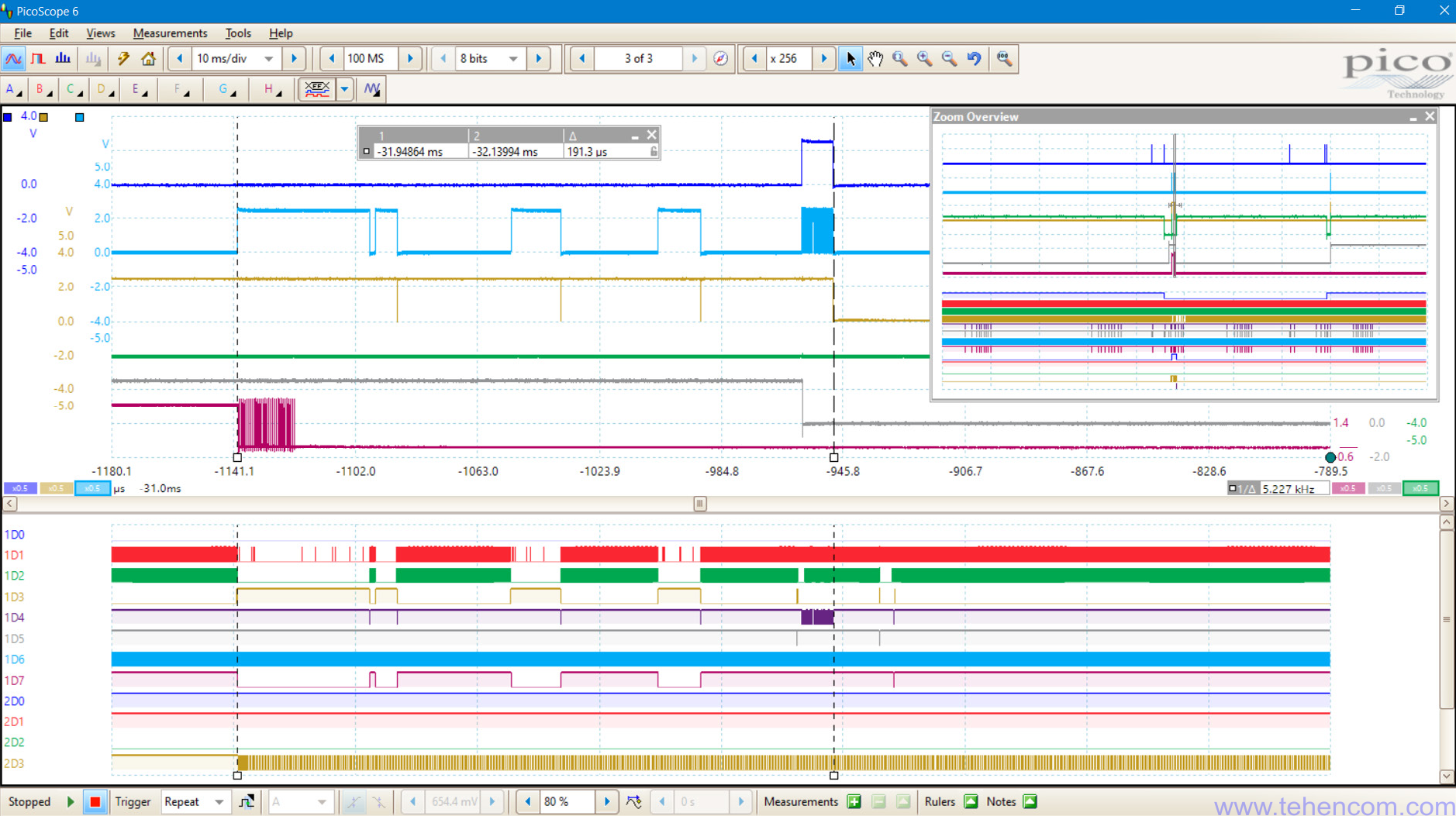
Standard and arbitrary waveform generator
All PicoScope 6000E Series oscilloscopes include a built-in standard and arbitrary waveform generator with a maximum amplitude of -5 V to +5 V.
Standard Signal Generator can be used to generate: sine and rectangle (up to 50 MHz), triangle, constant voltage, rising waveform, falling waveform, sinc function waveform, Gaussian noise, etc.
Arbitrary Waveform Generator (AWG) contains an accurate 14-bit DAC with a refresh rate that can be set from 1 S/s to 200 MS/s. The data comes from the DAC buffer, 40,960 samples in size. The minimum step amplitude of the generated signal is less than 1 mV.
This screenshot shows an example of setting up the PicoScope 6000E series arbitrary waveform generator in the PicoScope 6 control program.
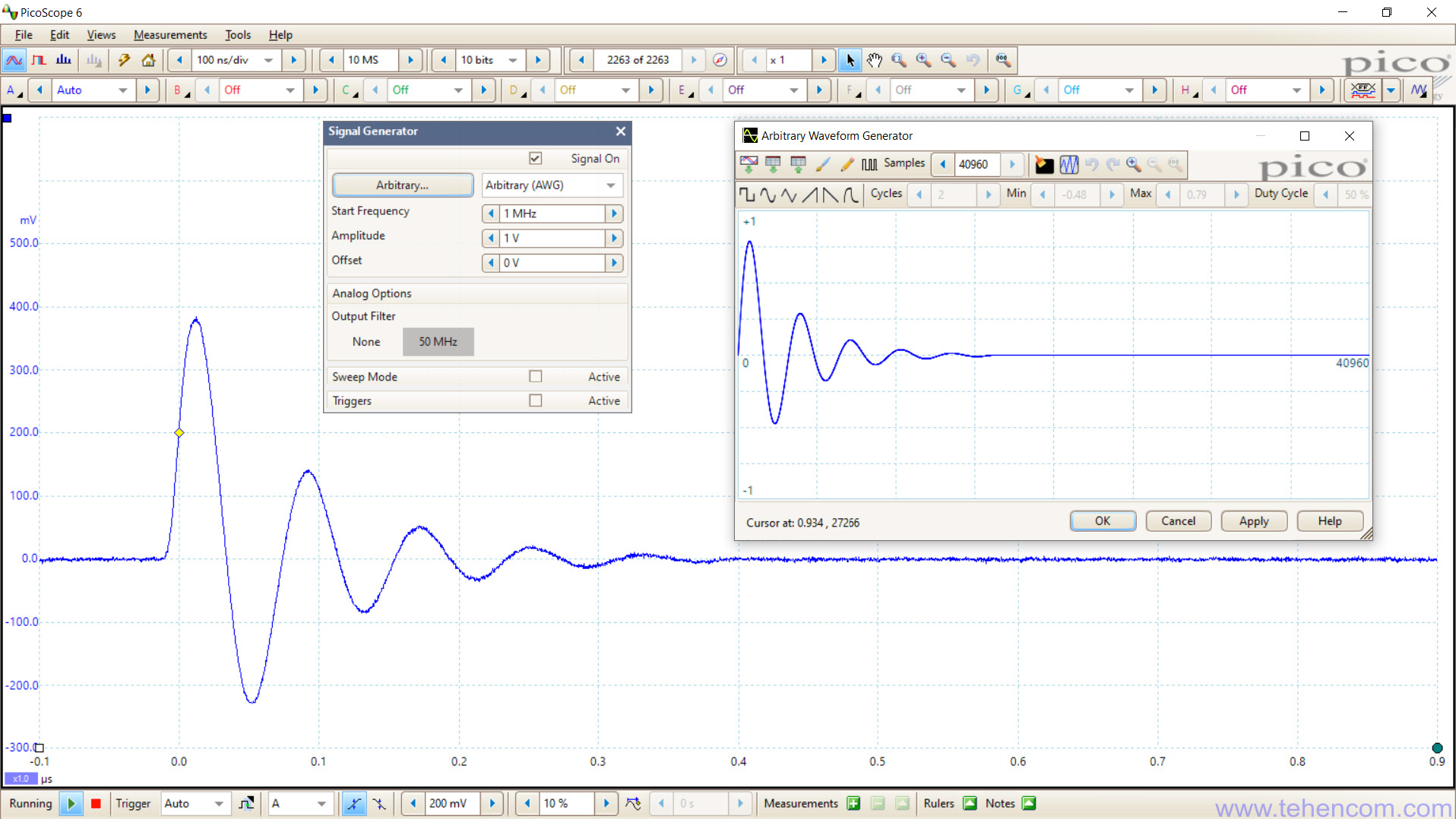
Specifications
Here is a list of the main technical specifications of Pico Technology's PicoScope 6000E series USB digital oscilloscopes. For detailed technical specifications, see below on this page in the section Documentation.
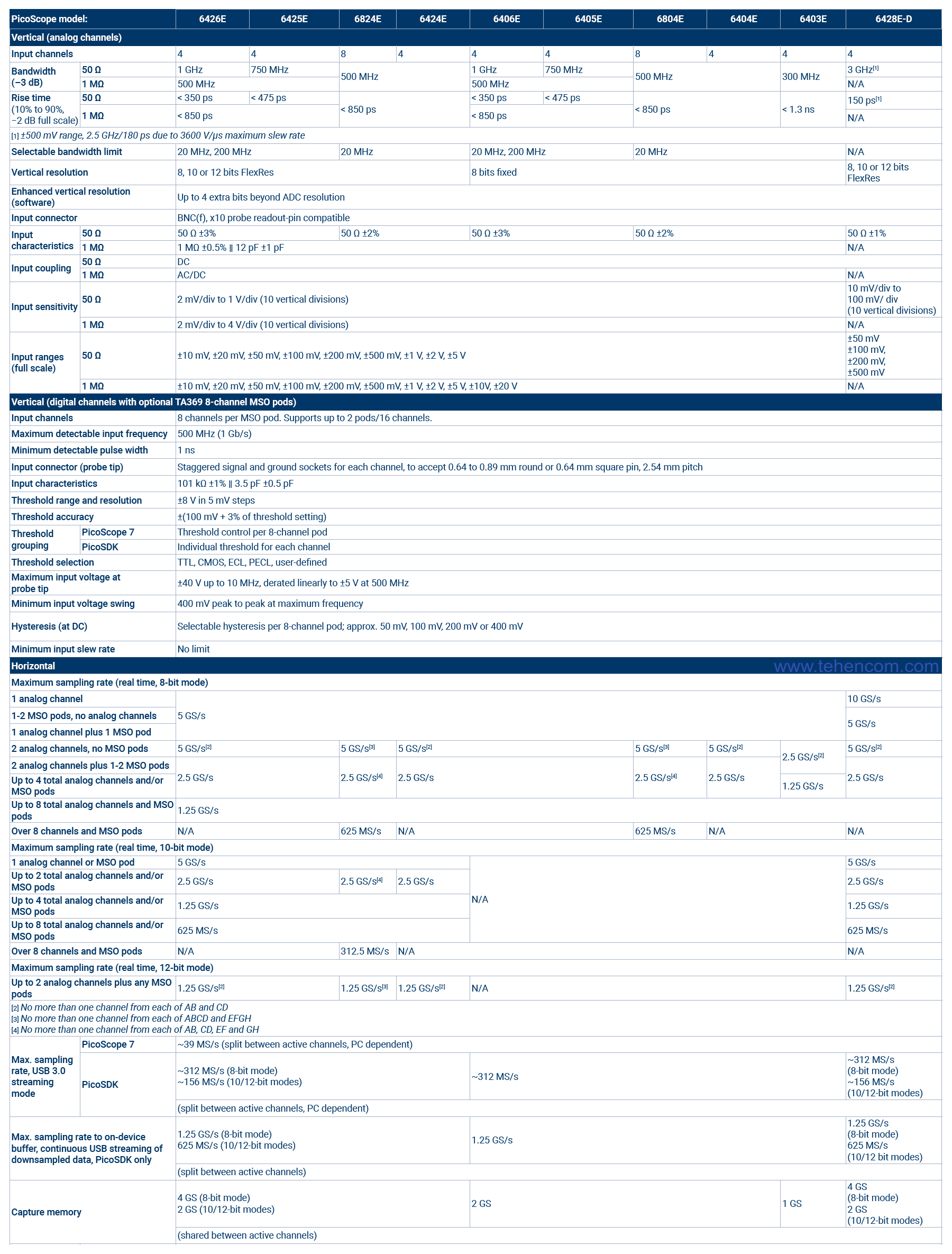
Package contents of PicoScope 6000E
| Name | Short description |
| Pico Technology PicoScope 6403E |
Digital oscilloscope, bandwidth 300 MHz, 4 channels, ADC 8 bits, sampling rate up to 5 GS/s, total record length 1024 M points. Includes 4 passive probes P2036 (300 MHz, 10:1). Up to 16 digital channels can be added using the TA369 digital probes. |
| or | |
| Pico Technology PicoScope 6404E |
Digital oscilloscope, bandwidth 500 MHz, 4 channels, ADC 8 bits, sampling rate up to 5 GS/s, total record length 2048 M points. Includes 4 passive probes P2056 (500 MHz, 10:1). Up to 16 digital channels can be added using the TA369 digital probes. |
| or | |
| Pico Technology PicoScope 6424E |
Digital oscilloscope, bandwidth 500 MHz, 4 channels, ADC 8-12 bit, sampling rate up to 5 GS/s, total recording length 4096 M points. Includes 4 passive probes P2056 (500 MHz, 10:1). Up to 16 digital channels can be added using the TA369 digital probes. |
| or | |
| Pico Technology PicoScope 6804E |
Digital oscilloscope, bandwidth 500 MHz, 8 channels, ADC 8 bits, sampling rate up to 5 GS/s, total record length 2048 M points. Includes 4 passive probes P2056 (500 MHz, 10:1). Up to 16 digital channels can be added using the TA369 digital probes. |
| or | |
| Pico Technology PicoScope 6824E |
Digital oscilloscope, bandwidth 500 MHz, 8 channels, ADC 8-12 bit, sampling rate up to 5 GS/s, total recording length 4096 M points. Includes 4 passive probes P2056 (500 MHz, 10:1). Up to 16 digital channels can be added using the TA369 digital probes. |
| or | |
| Pico Technology PicoScope 6405E |
Digital oscilloscope, bandwidth 750 MHz, 4 channels, ADC 8 bit, sampling rate up to 5 GS/s, total recording length 2048 M points. Includes 4 passive probes P2056 (500 MHz, 10:1). Up to 16 digital channels can be added using the TA369 digital probes. |
| or | |
| Pico Technology PicoScope 6425E |
Digital oscilloscope, bandwidth 750 MHz, 4 channels, ADC 8-12 bit, sampling rate up to 5 GS/s, total recording length 4096 M points. Includes 4 passive probes P2056 (500 MHz, 10:1). Up to 16 digital channels can be added using the TA369 digital probes. |
| or | |
| Pico Technology PicoScope 6406E |
Digital oscilloscope, bandwidth 1 GHz, 4 channels, ADC 8 bit, sampling rate up to 5 GS/s, total recording length 2048 M points. Includes 4 passive probes P2056 (500 MHz, 10:1). Up to 16 digital channels can be added using the TA369 digital probes. |
| or | |
| Pico Technology PicoScope 6426E |
Digital oscilloscope, bandwidth 1 GHz, 4 channels, ADC 8-12 bit, sampling rate up to 5 GS/s, total recording length 4096 M points. Includes 4 passive probes P2056 (500 MHz, 10:1). Up to 16 digital channels can be added using the TA369 digital probes. |
| or | |
| Pico Technology PicoScope 6428E-D |
Digital oscilloscope, bandwidth 3 GHz, 4 channels, ADC 8-12 bit, sampling rate up to 10 GS/s, total recording length 4096 M points. Up to 16 digital channels can be added using the TA369 digital probes. |
| plus: | |
| - | USB 3.0 cable (1.8 meters) |
| - | Power supply 12 V |
| - | Mains power cord 220 V |
| - | Quick start-up and safety guide |
| - | Russified PicoScope 6 software for controlling a USB oscilloscope (downloaded from the site) |
| - | Plastic transport case |
| - | 1 year warranty (can be extended to 3 and 5 years) |
The standard package of Pico Technology's eight-channel digital oscilloscopes of the PicoScope 6000E series is shown in the photo below. See the delivery set of four-channel oscilloscopes of this series below on this page in the section Documentation. For a list of optional accessories that may be included with these oscilloscopes, see Options and accessories.
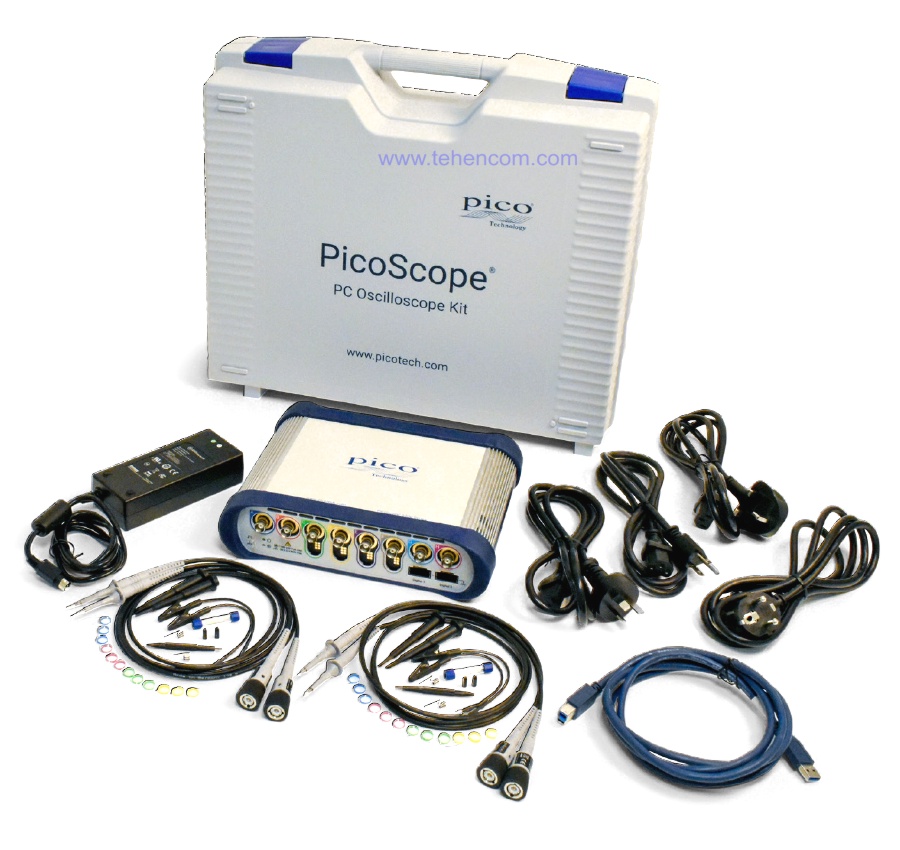
Options and accessories for PicoScope 6000E
Below is a list of recommended accessories that can be added to the PicoScope 6000E series USB oscilloscopes to enhance their functionality. For a complete list of options and accessories with a detailed description, see below on this page in the section Documentation.
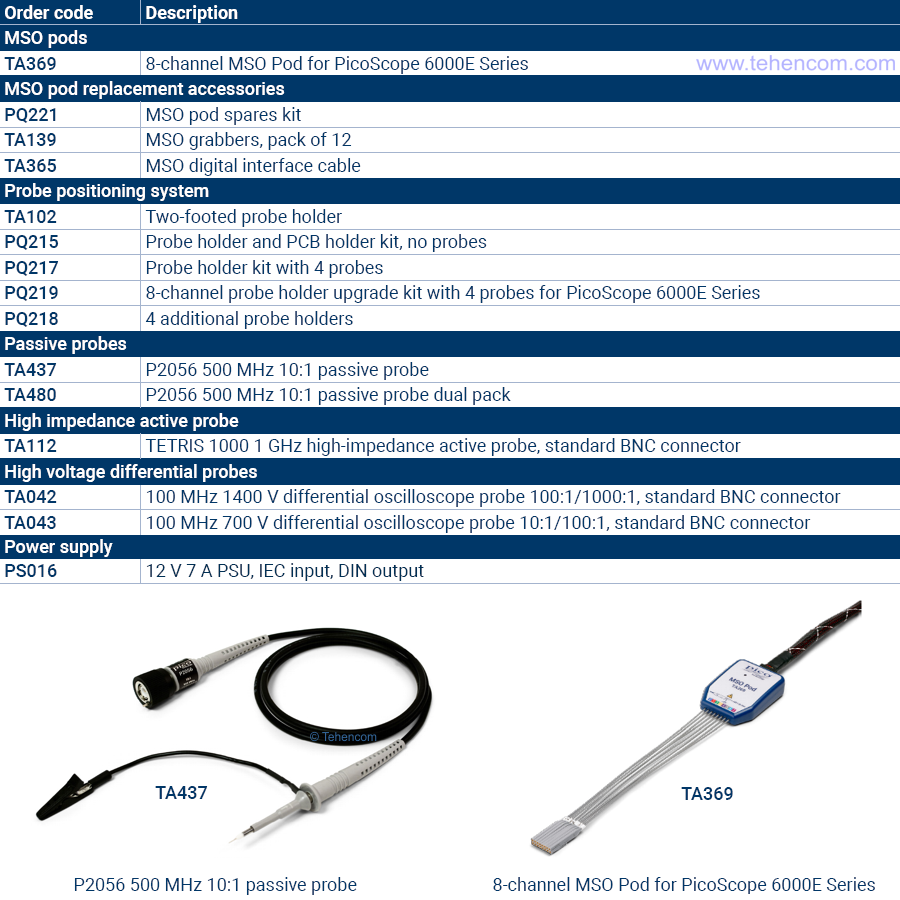
Documentation
This PDF documentation contains the most comprehensive description of the capabilities of eight-channel oscilloscopes. Pico Technology PicoScope 6000E series, their specifications and operating modes:
Description and characteristics of USB oscilloscopes PicoScope 6000E (in English) (42 pages; 11 MB)
PicoScope 6 User Guide (in English) (239 pages; 9 MB)
PicoScope 6 User Manual (in Russian) (216 pages; 7 MB)
And here you can find our tips and other useful information on this topic:
How to quickly choose an oscilloscope – selection criteria, typical applications and popular models
Comparison of oscilloscopes with a bandwidth of 500 MHz
DPO digital phosphor technology in oscilloscopes - principle of operation, application examples
How to buy equipment cheaper – discounts, special prices, demo and used devices
To simplify the process of choosing an oscilloscope, you can use our experience and recommendations. We have over 20 years of practical supply experience and can immediately answer many questions about models, options, delivery times, prices and discounts. This will save your time and money. For this it's simple call us or write to us at E-mail and we will be happy to answer your questions.

